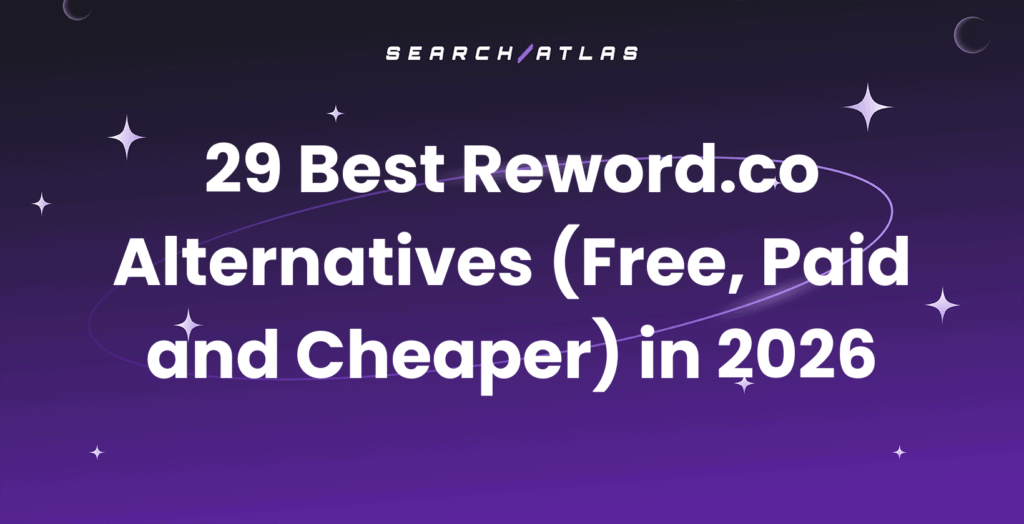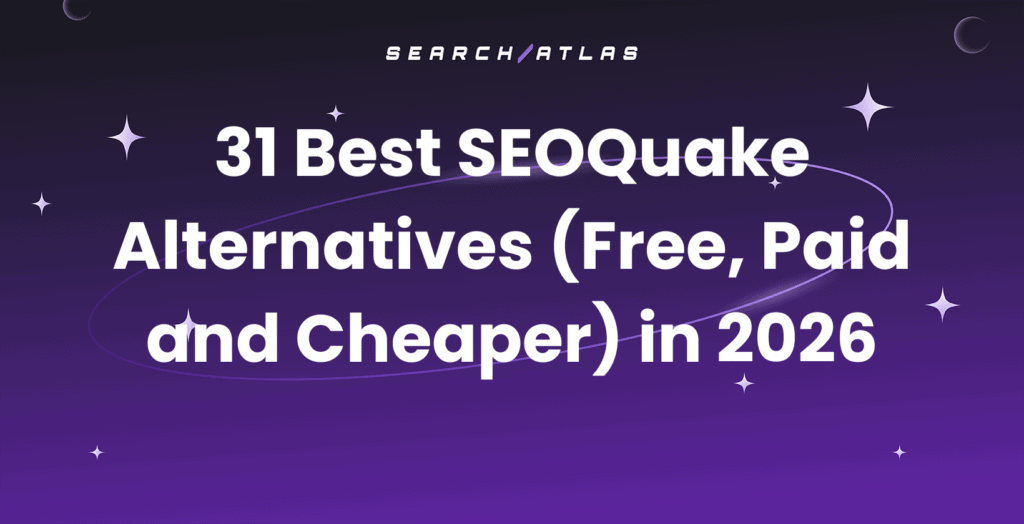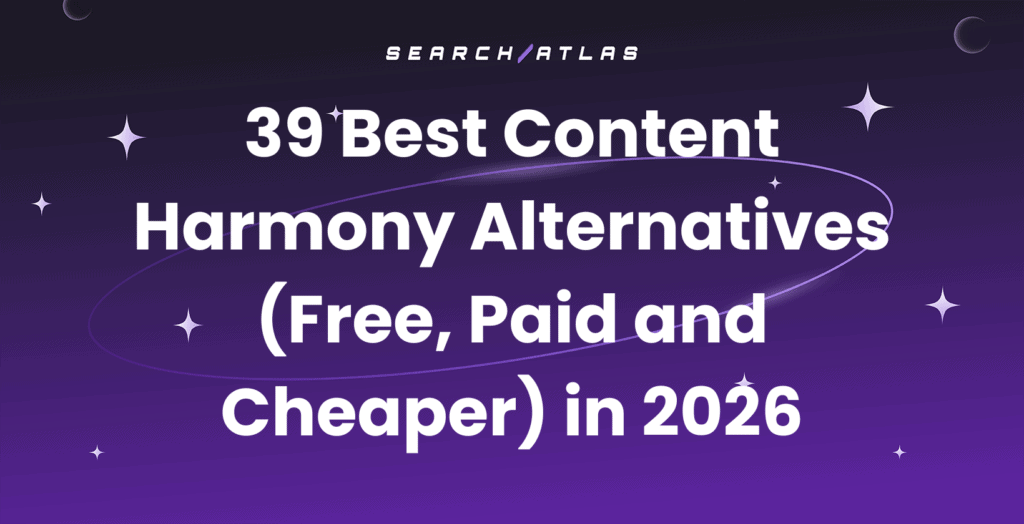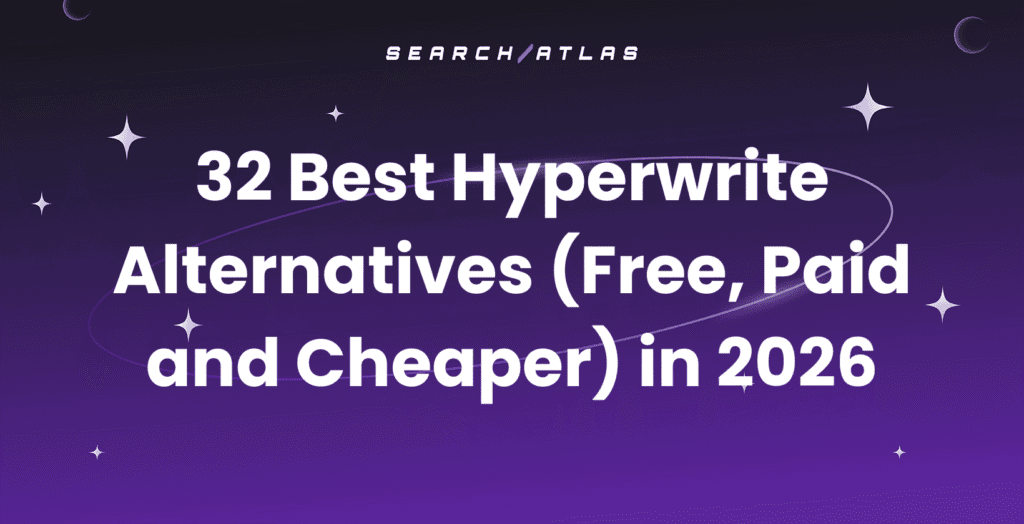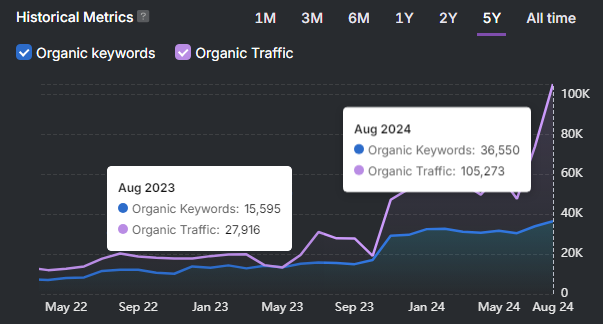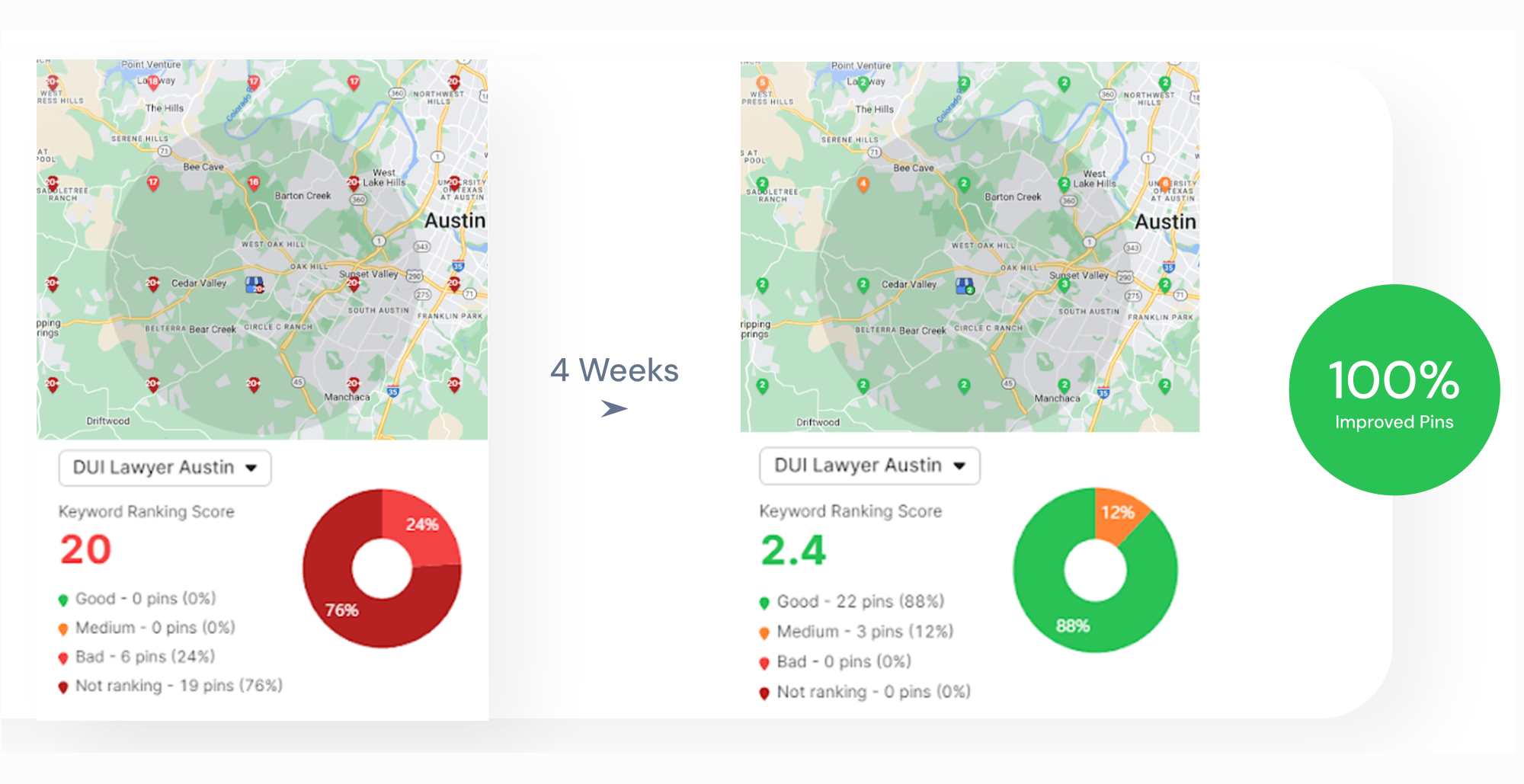Video SEO is the practice of optimizing video content to improve its visibility and ranking in search engine results pages (SERPs) and on video platforms like YouTube. The importance of video SEO lies in its ability to boost engagement, increase watch time, and encourage sharing, some of the signals search engines value when ranking content.
Businesses should follow certain best practices to get the most out of video search engine optimization. The video SEO best practices include conducting thorough keyword research and creating high-quality and valuable content. SEO video marketing strategies improve discoverability, contribute to stronger brand authority, and increase conversion rates over time.
What is Video SEO?
Video SEO is the process of optimizing video content so that it ranks high in search engines like Google and video-sharing platforms like YouTube. Video SEO is crucial to help you reach a wider audience, drive more traffic, and increase engagement, and is gaining increasing popularity within the digital marketing field. Studies on video SEO show that videos appearing on the first page of Google results are 53 times more likely to get views and clicks compared to text-only content.
The main goal of SEO for videos is to get paid and unpaid organic traffic from SERPs, similar to regular SEO for web pages. Effective video content SEO involves tailoring your video content and associated metadata to match what your target audience is searching for online. Video SEO strategies include optimizing video titles, descriptions, tags, thumbnails, and the actual content of your videos to maximize their visibility and engagement.
What is Video Optimization in the overall SEO Marketing?
Video optimization plays a significant role in the overall SEO marketing strategy and directly contributes to improving your website’s search rankings and online visibility. Video optimization for SEO improves engagement, reduces bounce rates, and increases dwell time, which are some of the crucial factors that search engines like Google use to evaluate content quality and relevance.
Optimized videos encourage users to share content across social platforms, which helps generate backlinks, drive more traffic to your site, and improve your domain authority. Video optimization strategies, such as adding transcripts, closed captions, and schema markup, improve accessibility while providing search engines with additional keyword-rich content to crawl and index.
Videos should be an integral part of your SEO marketing strategy, especially if you run an e-commerce business. Online shoppers prefer watching product demonstration videos, unboxings, and customer testimonials before making a purchase. In fact, 84% of consumers say they have been convinced to buy a product after watching a brand’s video. Additionally, SEO and videos for your e-commerce business will help it stand out in SERPs by making your product pages more informative and engaging.
What is the Importance of Videos for SEO?
The importance of video SEO lies in its ability to increase both search rankings and organic traffic. Videos can capture the audience’s attention more effectively than text alone and encourage users to stay longer on your site. When visitors engage with your content for an extended period, it signals to search engines that your page is valuable and relevant, positively influencing your rankings.
Beyond rankings, videos have a major impact on user engagement and retention. Users are likely to spend more time on a page that includes video, reducing bounce rates and increasing dwell time. Video content creates multiple opportunities for search visibility and can appear in traditional search listings, dedicated video tabs, and featured snippets, helping you gain more exposure on competitive keywords and stand out across SERPs.
Video content performs exceptionally well on mobile devices, and with Google’s shift to mobile-first indexing, content that delivers a superior mobile experience gains preference in rankings. Videos align perfectly with mobile users’ preferences for easily consumable, engaging content that does not require extensive reading on smaller screens.
Video content generates valuable backlink opportunities. When your videos are informative, entertaining, or original, other websites are more likely to link to or embed them as references. These natural backlinks serve as strong authority signals to search engines, improving your domain trust and overall ranking potential. Additionally, videos simplify complex information and improve accessibility, leading to improved user satisfaction and more time spent on your site.
How to Optimize Videos for SEO and Get Ranked on Google?
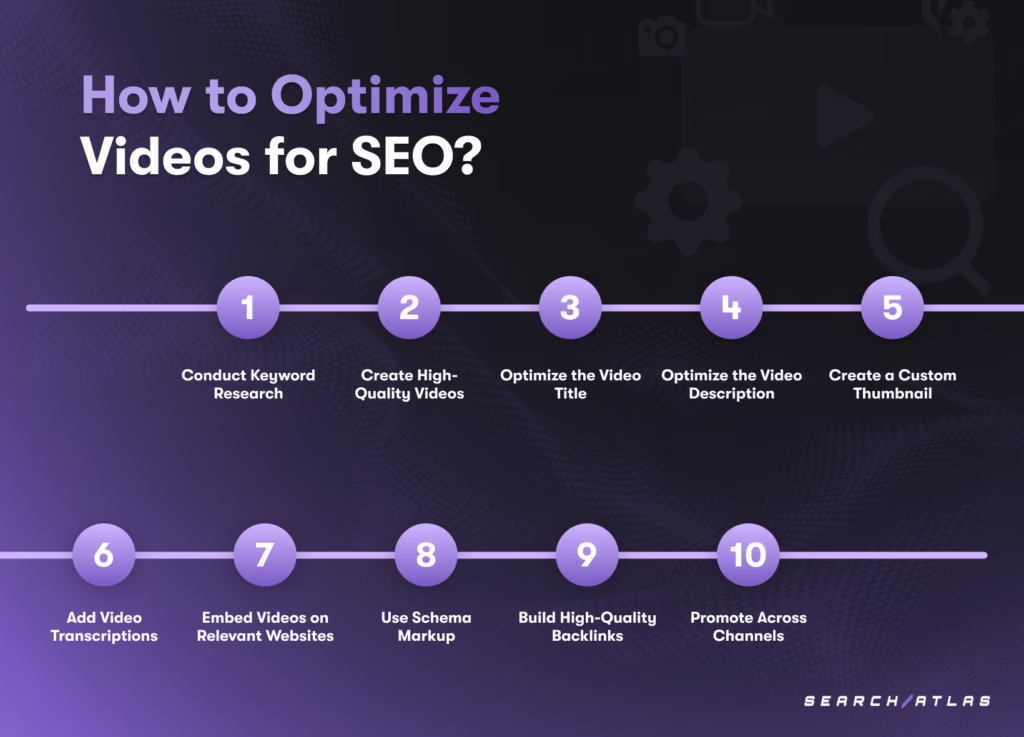
There are 10 ways to optimize videos for SEO and get ranked on Google. The video SEO best practices are listed below.
1. Conduct Keyword Research
Conducting keyword research is the process of identifying the words and phrases your target audience uses when searching for videos online. Conducting keyword research makes sure that your video is created around popular search queries and helps your video appear in both YouTube and Google results pages. Using relevant keywords in your title, description, and tags signals to search engines that your content is valuable and relevant, making it easier to index and rank, and ultimately increasing visibility and driving more targeted traffic.
The best practices for conducting keyword research are listed below.
- Use tools like Google Keyword Planner or Search Atlas’s Keyword Magic Tool.
- Focus on long-tail keywords that are specific and less competitive.
- Look for keywords that trigger video results in Google (video-intent keywords).
- Analyze top-ranking videos for your topic to see what keywords they use.
- Prioritize keywords with high search volume and low to medium competition.
- Incorporate keywords naturally into your title, description, tags, and spoken content.
Conducting keyword research should be an integral part of your content planning process. Strategic keyword research increases views and engagement and helps establish your authority in your niche over time. By investing a bit of time upfront into keyword research, you are setting a strong SEO foundation that can bring long-term traffic to your videos.
The Search Atlas Keyword Magic Tool helps you simplify the keyword research process and uncover popular and relevant search terms with ease. The Search Atlas Keyword Research Tool provides insights into metrics like search volume, competition, CPC, and keyword variations to help you target the right terms and maximize your video’s visibility and engagement.

The Search Atlas Keyword Magic Tool allows you to add relevant brand or product names to generate more targeted, product- or brand-specific keywords. Additionally, the Search Atlas Keyword Research tool offers the option to exclude certain keywords from your results for more precise targeting. To do this, simply navigate to the top of the results section, click on “Include“ or “Exclude,” and enter the keywords you want to filter in or out.
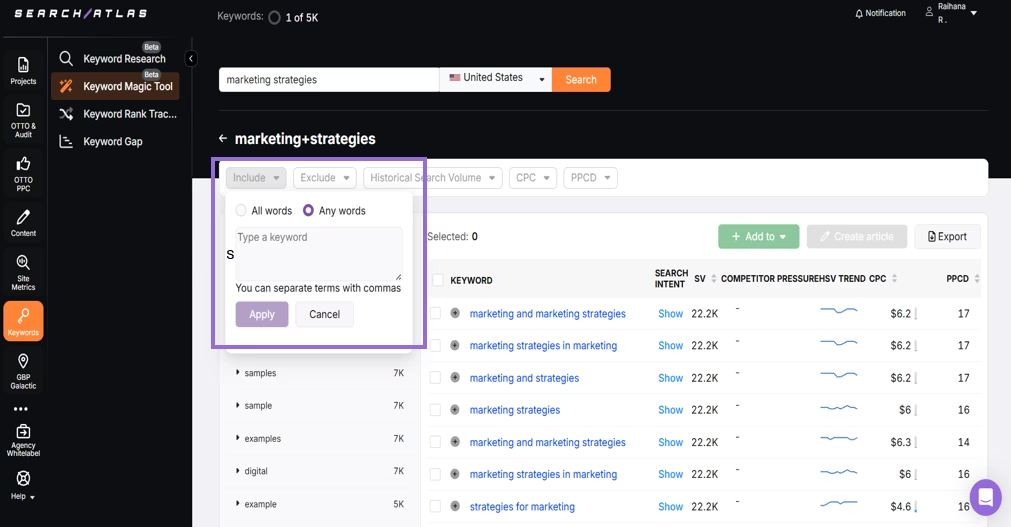
2. Create High-Quality Videos
Creating high-quality videos for SEO means producing content that is visually appealing, well-edited, clearly structured, and valuable to your target audience. Creating high-quality videos includes good lighting, clear audio, engaging visuals, and professional editing. High-quality videos contribute to longer watch times, more shares, higher user satisfaction, and stronger viewer retention, which are key metrics that positively influence your video’s rankings in search and suggested results.
The tips for creating high-quality videos are given below.
- Use a good camera and microphone for clear visuals and crisp audio.
- Keep your video focused and well-structured to maintain viewer attention.
- Edit out distractions or filler content to improve pacing and professionalism.
- Add relevant visuals, graphics, and captions to enhance understanding.
- Start strong and try to hook your audience in the first 10 seconds.
High-quality video production delivers value and keeps your audience engaged. When your content looks and sounds professional, viewers are more likely to watch it through, interact with it, and share it with others, sending strong positive signals to search engines and increasing your chances of ranking higher.
3. Optimize the Video Title
Optimizing the video title means crafting a clear, compelling, and keyword-rich headline that tells viewers what your video is about. Optimizing the video title helps search engines understand your video’s content and improves your chances of ranking high on Google and YouTube. Optimized video titles play a major role in both click-through rates (CTR) and visibility, as it is one of the first elements users and search engines see, improving SEO performance.
The tips for optimizing the video title are listed below.
- Include your target keyword as close to the beginning of the title as possible.
- Keep titles clear, concise, and under 60 characters.
- Make the title engaging or curiosity-driven to increase clicks.
- Avoid clickbait by promising value and delivering it in your video.
- Use numbers or power words (e.g., “Top 5,” “Easy,” “Step-by-Step”) for better performance.
- Capitalize important words for better readability and emphasis.
Effective video title optimization should clearly tell what the content is about while encouraging people to learn more. A strong, well-optimized video title combined with keyword research will improve search visibility and increase the likelihood that viewers will click and watch.
4. Optimize the Video Description
Optimizing the video description means writing a clear, detailed, and keyword-rich summary that improves both search engine visibility and viewer understanding. Optimizing the video description helps algorithms and audiences quickly grasp what your video is about. An optimized description improves your chances of ranking higher by giving search engines more context to index your content accurately. Optimized video descriptions help your video appear in suggested results and increase engagement by guiding viewers with helpful information and links.
The best practices for optimizing video descriptions are outlined below.
- Place your primary keyword within the first 1–2 lines.
- Write 250–300 words to give enough detail and relevance.
- Add timestamps to break down key moments or sections in longer videos.
- Include relevant links to your website, social platforms, or related videos.
- Use calls to action like “Subscribe,” “Watch next,” or “Learn more.”
- Maintain a natural tone and avoid keyword stuffing.
Optimizing the video description is about making your content useful and accessible to viewers while providing search engines with enough context to understand and rank your video. A well-structured description can improve your video’s discoverability, encourage longer watch time, and prompt more interaction, all of which signal to platforms like YouTube and Google that your content is valuable.
5. Create a Custom Thumbnail
Creating a custom thumbnail refers to manually designing an image that best represents your video content. Creating a custom thumbnail grabs attention and gives viewers a reason to click, compared to using a random frame that is auto-generated by YouTube. A visually appealing thumbnail significantly impacts click-through rates, sending positive signals to YouTube and Google that your video is relevant and engaging and helping it rank better in search and suggested videos.
The best practices for creating a custom thumbnail are listed below.
- Use bold, readable text to highlight the video’s topic.
- Choose contrasting colors and a clean layout to make it stand out.
- Include faces with expressive emotions to create a human connection.
- Stick to a 16:9 aspect ratio (1280×720 pixels) and save it under 2 MB.
- Make sure the thumbnail is accurate and represents the actual content.
- Add branding elements like a logo or color scheme for consistency.
Creating a compelling, custom thumbnail helps you stand out in search results, boosts your CTR, and encourages more views. Since YouTube rewards videos with high engagement, a well-designed thumbnail can make a huge difference in how far your content reaches.
6. Add Video Transcriptions
Adding video transcriptions means displaying the spoken content in your video as captions or including them in the description to make your content more accessible to a wider audience. Adding video transcriptions helps search engines better understand the context and keywords in your video, improving indexing and visibility. Video transcriptions enhance user experience by making your video accessible to viewers who are deaf or hard of hearing, or those watching without sound.
To add video transcriptions, consider the tips given below.
- Upload accurate subtitles or closed captions to your video.
- Use tools like YouTube’s automatic captions, but review and edit them for accuracy.
- Include a full or partial transcript in the video description for extra keyword relevance.
- Consider adding timestamps in the transcript to help viewers navigate.
- Ensure the transcription matches the spoken content naturally and avoid keyword stuffing.
Adding transcriptions allows a wider audience to engage with your content, supports better comprehension, and can lead to longer watch times and higher engagement, which can positively impact your video’s search performance.
7. Embed Videos on Relevant Websites
Embedding a video refers to the practice of placing videos on external websites, such as blogs, news articles, or partner sites, so they play directly from platforms like YouTube or Vimeo. Embedding a video on relevant, high-authority websites can help you increase visibility, generate more views, and drive referral traffic. Embedded videos help boost engagement metrics like watch time and shares, which are positive signals to YouTube and Google.
The best practices for embedding videos on relevant websites are outlined below.
- Embed videos on websites or pages related to your video’s topic.
- Choose platforms with high domain authority for better SEO impact.
- Add contextual content, like a summary or article, around the embedded video.
- Encourage partners, bloggers, or affiliates to share and embed your video.
- Make sure the video is mobile-friendly and loads quickly on the site.
Embedding your video in the right places helps you reach a broader audience and improve SEO performance. Embedded videos are a great way to repurpose your content, attract new viewers, and reinforce its relevance across multiple platforms.
8. Use Schema Markup
Using schema markup refers to the process of adding structured data, such as the title, description, upload date, thumbnail, and video duration, to your website’s HTML to help search engines understand the content of your page better. Using schema markup improves how your video appears in search results by enabling rich snippets, such as thumbnails, descriptions, and duration info, contributing to improved click-through rates. Schema markup helps search engines index your video content more accurately, increasing the chances of your video showing up in Google’s video search or featured snippets.
To add structured data, consider the best practices listed below.
- Use Google’s Structured Data Markup Helper or Search Atlas’s Schema Markup Generator to tag important video details.
- Include key fields like name, description, thumbnail URL, upload date, and content URL.
- Test your markup using Google’s Rich Results Test to ensure it is correctly implemented.
- Keep the markup updated if any video details change over time.
Adding schema markup does not directly boost rankings, but it makes your video more visible and attractive in search results, leading to more clicks and better engagement. Schema markups are generally a technical step that adds clarity for search engines and helps your content stand out.
The Search Atlas Schema Markup Generator Tool helps you create accurate JSON-LD markups in line with Schema.org standards, including all relevant item properties and optional enhancements to make sure your website content is properly understood by search engines. The Search Atlas Schema Markup Generator Tool automatically generates the necessary code snippets, including HTML tags, so you can easily copy and paste them into the backend of your website.
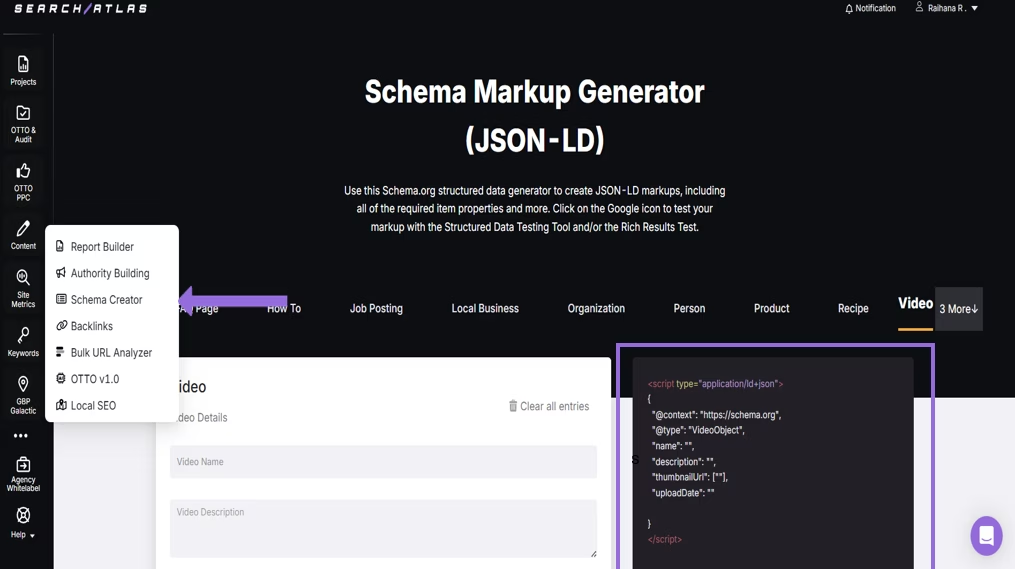
The Search Atlas Schema Markup Generator Tool provides a convenient option to test your generated schema using Google’s Rich Results Test. This built-in feature allows you to quickly identify any errors or issues within your markup and makes sure that your structured data is properly formatted. Additionally, the test confirms whether Google is able to generate rich results from your schema, helping you validate your implementation before adding it to your site.
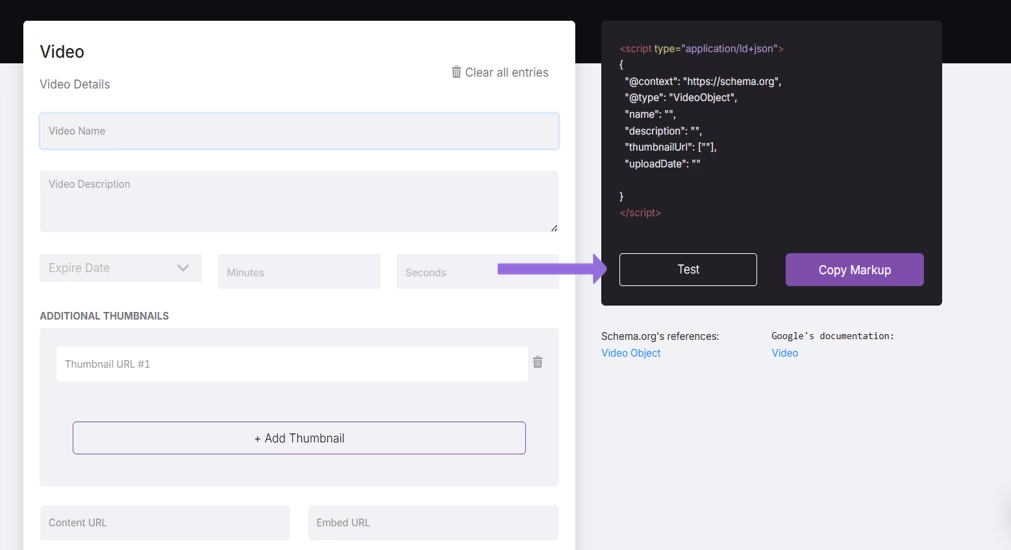
9. Build High-Quality Backlinks
Building high-quality backlinks refers to the process of getting other reputable websites to link to your video or the page where your video is embedded. Building high-quality backlinks improves your domain authority, increases referral traffic, and boosts your video’s chances of ranking higher in both Google and YouTube search results. Backlinks act as votes of confidence, signaling to search engines that your content is trustworthy and valuable.
The best practices for building high-quality backlinks are listed below.
- Reach out to blogs and websites in your niche and ask them to feature your video.
- Publish guest posts that include a link to your video or landing page.
- Create shareable, valuable video content that others naturally want to link to.
- Submit your videos to relevant directories, forums, and community platforms.
- Collaborate with influencers or partners who can embed your video on their platforms.
Building backlinks strengthens your website’s SEO and builds credibility for your brand. When your video is referenced or shared by respected sources in your industry, it increases trust among both viewers and search engines.
The Search Atlas Backlink Research Tool allows you to analyze domain- and page-level backlink metrics for your website, URL, or subdomain to uncover opportunities for boosting traffic and engagement. The Search Atlas Backlink Research Tool helps you identify which domains are linking to your site or page, the quality of those links, and how they impact your site’s SEO performance. Additionally, the Search Atlas Backlink Research tool helps track competitors’ link profiles and find content gaps you can turn into link-building opportunities.

10. Promote Across Channels
Promoting across channels means sharing your video on multiple platforms, such as social media, email newsletters, press releases, blogs, and forums, to reach a wider audience. Promoting across channels helps increase traffic and engagement, sending strong signals to search engines about your video’s relevance and popularity and indirectly boosting your video’s ranking on both YouTube and Google.
To promote your video across channels, follow the tips listed below.
- Share your video on all major social media platforms, such as Facebook, LinkedIn, X/Twitter, and Instagram.
- Include your video in email campaigns, newsletters, or press releases to engage subscribers.
- Repurpose your video content into blog posts or short clips for different platforms.
- Engage with online communities or forums where your target audience spends time.
- Use paid promotions or influencer partnerships to reach a larger audience quickly.
Promoting your video across multiple channels maximizes its reach and increases the likelihood of shares, backlinks, and engagement, all of which help build momentum and authority for your video content. A well-executed promotion strategy makes sure that your video continues to generate views and traffic long after it’s published.
The Search Atlas OTTO SEO’s Press Release Distribution feature uses AI to help you quickly generate professional, SEO-optimized press releases that are tailored to your brand, product, or announcement. Once created, the Search Atlas OTTO SEO’s Press Release Distribution feature lets you select from a wide range of trusted distribution channels to make sure your press release reaches the right audience, media outlets, and industry platforms.
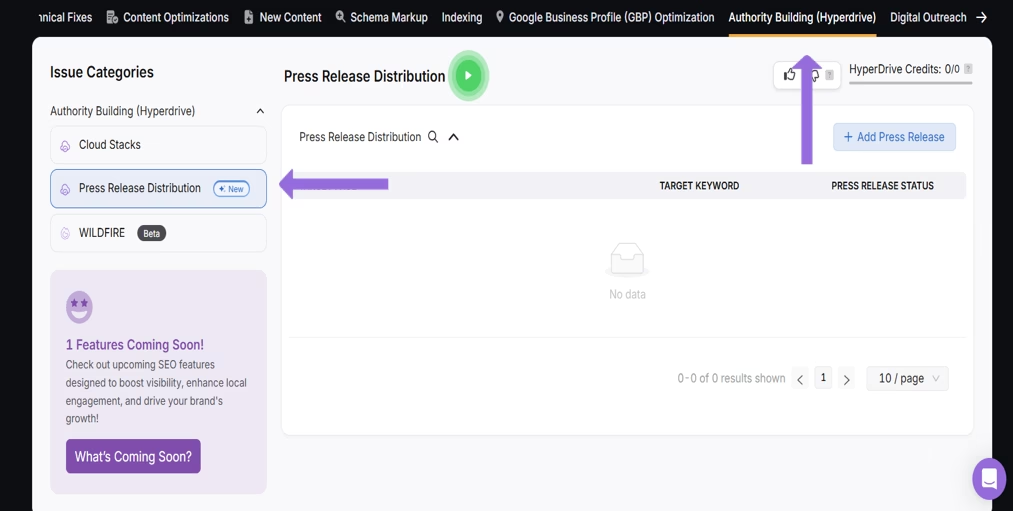
What are the Best Video Embedding Platforms for SEO?
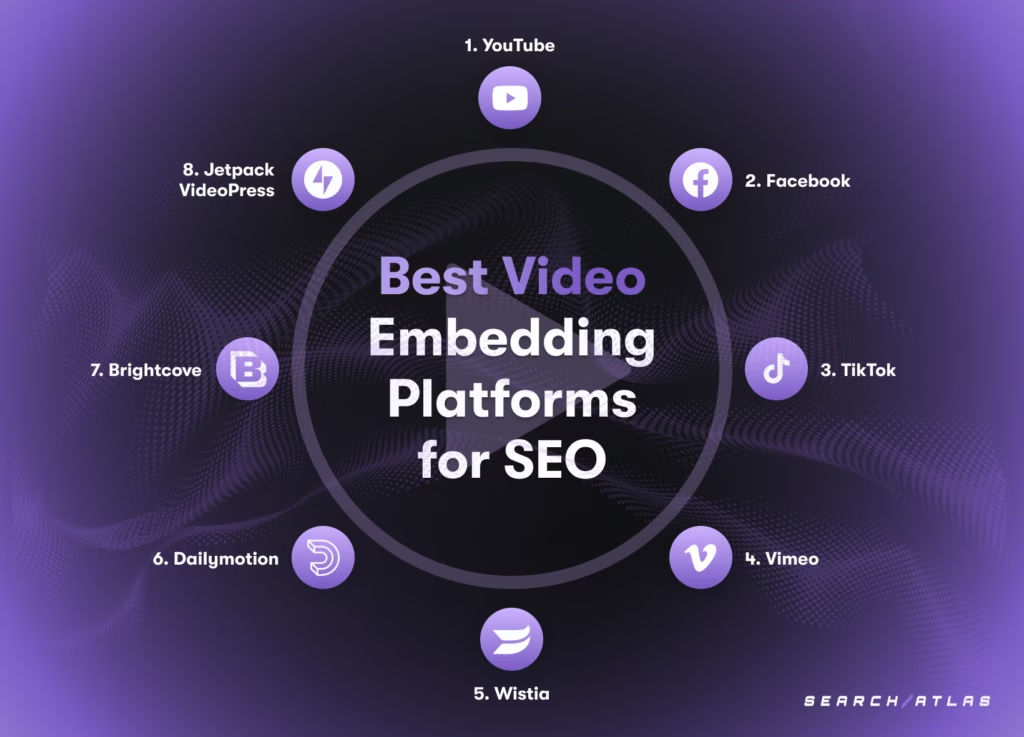
There are 8 best video embedding platforms for SEO that can help improve your content’s visibility and search engine performance. These are YouTube, Facebook, TikTok, Vimeo, Wistia, Dailymotion, Brightcove, and Jetpack VideoPress.
- YouTube. YouTube is the most popular video SEO platform that offers strong search visibility due to its integration with Google. YouTube supports detailed metadata, custom thumbnails, and closed captions, making it easier for your videos to rank in both YouTube and Google search results.
- Facebook. Facebook is primarily a social platform, but videos on it can still be indexed by search engines if properly optimized. Native video uploads often receive more engagement, and with the right descriptions and tags, Facebook can be a valuable part of your video SEO strategy.
- TikTok. TikTok is known for short-form, high-engagement content and is increasingly appearing in search results. Optimized TikTok videos with relevant hashtags and captions can help improve discoverability across platforms and even in Google searches.
- Vimeo. Vimeo is a cleaner, ad-free video SEO platform that is ideal for professional content. Vimeo offers customization options and SEO-friendly features, such as editable titles and descriptions, which can help improve video performance on your website.
- Wistia. Wistia is a premium video SEO platform tailored for marketers and businesses. Wistia provides SEO-focused tools like schema markup, customizable embed codes, and detailed analytics, and is an excellent choice for driving traffic and tracking user engagement.
- Dailymotion. Dailymotion is a global video-sharing platform that supports video optimization through metadata and offers additional reach, particularly in European markets. Dailymotion is not as SEO-friendly as YouTube, but it still offers opportunities for traffic and visibility when content is properly optimized.
- Brightcove. Brightcove combines video hosting with marketing tools and is specifically designed for large enterprises. Brightcove offers SEO-ready embeds, advanced analytics, and content management features for scaling video campaigns.
- Jetpack VideoPress. Jetpack VideoPress is a solid video SEO platform if your site is built on WordPress. Jetpack VideoPress offers fast, lightweight video hosting with SEO-friendly embedding that helps keep viewers on your site while maintaining video quality and loading speed.
Does Hosting Videos on YouTube Improve SEO for a Website?
Yes, hosting videos on YouTube does improve SEO for a website. YouTube is the second-largest search engine and is owned and favored by Google, which means well-optimized content using YouTube SEO techniques has a strong chance of appearing in Google’s search results. While the video itself may not directly boost your website’s rankings, it can drive indirect SEO benefits such as increased brand visibility, referral traffic, and backlinks, supporting your SEO strategy.
What Tools Do Video SEO Experts Use to Track Video Performance?
Video SEO experts use a mix of specialized tools to track video performance, uncover insights, and refine strategies. The most common video SEO tools experts use to track video performance are listed below.
- Google Search Console. Google Search Console helps track how your videos appear in Google search results and shows which pages are indexed with video content, how often they appear in search, and how many clicks they receive. Additionally, Google Search Console flags any issues with video indexing, making sure your content meets Google’s requirements for rich results.
- Google Analytics. Google Analytics helps measure important engagement metrics like average time on page, bounce rate, and traffic sources. When paired with event tracking, Google Analytics lets you even monitor how users interact with video elements, such as play rate, pause frequency, and video completion.
- Search Atlas Page Explorer. The Search Atlas Site Auditor’s Page Explorer feature integrates with both Google Search Console and Google Analytics to help you track how your videos are performing. The Search Atlas Site Auditor’s Page Explorer feature allows you to monitor how your video content contributes to key engagement metrics like page views, bounce rates, average session duration, and user interactions.
- VidIQ. VidIQ is a YouTube-certified tool that helps track YouTube video performance in real-time, including views, watch time, SEO score, and engagement metrics. VidIQ shows how videos rank for specific keywords and compares performance with competitors.
- TubeBuddy. TubeBuddy offers detailed video performance tracking for YouTube, including click-through rates, retention graphs, and engagement stats. TubeBuddy helps monitor how well your videos are doing over time and what improvements can be made.
- Wistia. Wistia provides detailed viewer analytics, including heatmaps and engagement graphs that show how viewers interact with your videos. Wistia allows you to track how much of your video content is being watched and where viewers drop off.
- Brightcove. Brightcove tracks detailed performance data, including viewer engagement, watch duration, and conversion actions, linked to your videos. Brightcove is ideal for enterprise-level insights into video ROI and helps keep tabs on user engagement across the customer journey.
How Does AI Improve Video SEO?
AI is playing a major role in improving video SEO by making the process more efficient and data-driven. AI tools help content creators and marketers automate and improve many aspects of the video optimization process, like keyword research, metadata creation, and content analysis, making it faster, smarter, and more accurate. For example, AI tools can suggest highly relevant keywords based on search trends, helping your videos rank for what your audience is looking for.
Another key advantage of AI for video SEO is its ability to auto-generate captions, transcriptions, and even video summaries, which improves accessibility and boosts your search visibility by adding more indexable content. Additionally, AI tools can identify the best times to post, recommend optimal video lengths, and even help create high-performing thumbnails, all of which contribute to a more strategic and effective approach to video SEO.
What Businesses Need Video SEO the Most?
There are 10 businesses that need video SEO the most to improve online visibility and build customer trust. The businesses that need video SEO the most are listed below.
- Real Estate Businesses. Real estate businesses need high-quality videos to showcase property tours, neighborhood overviews, and client testimonials, increasing engagement and building trust. When paired with real estate SEO strategies, well-optimized videos can help listings appear in local search results and drive more qualified leads.
- E-commerce Businesses. E-commerce businesses benefit from product demos, unboxing videos, and customer reviews to boost conversions. When integrated with e-commerce SEO practices, these optimized videos improve visibility on Google and YouTube, driving both organic traffic and purchases.
- SaaS Companies. SaaS companies benefit from explainer videos, onboarding tutorials, and feature walkthroughs that make their products easier to understand. When aligned with SaaS SEO strategies, video SEO ensures these resources reach a wider audience, improve brand visibility, and support lead generation.
- Hospitality. Hotels, resorts, and vacation rentals need visual content to sell experiences. Virtual tours, guest stories, and location highlights perform especially well when optimized through hotel SEO, driving bookings, improving local search visibility, and increasing overall engagement.
- Travel and Tourism Companies. Travel and tourism companies benefit from destination guides, travel vlogs, and itinerary videos to build excitement and trust. When optimized through travel SEO, these engaging pieces have a better chance of ranking higher in search results, influencing travel decisions.
- Healthcare Providers and Clinics. Healthcare providers and clinics can use videos to share treatment explanations, introduce medical professionals, or highlight patient success stories to establish credibility and trust. With effective healthcare SEO and video optimization, these videos become more discoverable, helping providers connect with patients actively searching for reliable medical information online.
- Education and Online Learning Platforms. Educational institutions benefit from course previews, instructor intros, and tutorial snippets to attract students and boost sign-ups. Optimized video content supports higher visibility in educational search queries.
- Fitness and Wellness Brands. Workout routines, health tips, and transformation stories are highly shareable and benefit from video SEO by reaching health-conscious viewers across platforms.
- Legal and Financial Services. Legal and financial professionals can use videos to simplify complex topics like legal rights, tax strategies, or insurance options, making them more accessible to the average viewer. With strong video optimization and SEO for lawyers strategies, these videos can rank higher in search results, helping firms build authority, attract qualified leads, and stand out in a competitive market.
- Automotive Businesses. Car dealerships and auto service centers can use video content to showcase new models, maintenance tips, and customer reviews. When properly optimized, these videos support automotive SEO by improving visibility in local search results, enhancing engagement, and driving more foot traffic to showrooms or service bays.
How to Start a Video SEO Company?
Starting a video SEO company requires the right mix of technical skills, strategic planning, and marketing insight. The steps to start a video SEO company are given below.
- Develop your expertise. Start by mastering the core video SEO marketing strategies, like optimizing video metadata (titles, tags, descriptions, thumbnails), using structured data, and promoting videos across platforms like YouTube, Vimeo, and websites.
- Define your niche and services. Decide whether you’ll target a broad audience or focus on specific industries like real estate, e-commerce, or SaaS. Outline the services you’ll offer, such as video optimization, video content strategy, performance tracking, YouTube channel management, or schema markup setup.
- Build a portfolio. Before pitching to clients, you need to showcase your skills to prove that your methods work. Start by optimizing your own video content or offering free/discounted services to a few businesses in exchange for testimonials. Case studies showing improved rankings and traffic can go a long way in establishing credibility.
- Create a strong online presence. Set up a website that clearly explains your video SEO marketing offerings, including a services page, pricing or custom quote forms, and a blog where you share tips and industry insights. Make sure to use video content on your own site as well to demonstrate your expertise. Be active on platforms like LinkedIn, YouTube, and Twitter, where potential clients are likely to find you.
- Use the right tools. Invest in high-quality video SEO software to help streamline your workflow. Tools like Search Atlas SEO Software Platform allow you to handle everything from keyword tracking and metadata suggestions to backlink analysis and video performance monitoring.
- Pitch, network, and grow. Reach out to small businesses, content creators, and digital marketing agencies that might need video SEO services. Offer workshops, publish free resources, and attend industry events to build visibility and trust.
What is the Relation between Video SEO and Content SEO?
The relation between video SEO and content SEO is that they complement each other to improve your website’s overall search visibility and ranking potential by targeting different content formats.
Video SEO is the process of optimizing video content so it ranks higher on search engines like Google and platforms like YouTube. Content SEO, on the other hand, refers to the practice of optimizing all types of written and visual content on a website, such as blogs, landing pages, and product descriptions, to rank higher in search results. Content SEO includes keyword usage, meta tags, content structure, internal linking, and relevance to user intent.
When combined, video SEO and content SEO form a powerful SEO strategy that blends the appeal of visuals with the depth of written content, capturing your audience’s interest while meeting search engine requirements.
What is the Relation Between Video SEO and E-commerce SEO?
The relation between video SEO and e-commerce SEO is that they work hand in hand to boost product visibility, improve user experience, and help you attract more traffic that’s ready to convert.
Video SEO makes sure your videos show up where people are searching, like on Google, YouTube, and other platforms. E-commerce SEO, on the other hand, refers to the practice of optimizing your online store to rank higher in search engine results so that more people find your products. E-commerce SEO includes on-page optimization, such as product titles, descriptions, and images, technical SEO, such as site speed and mobile-friendliness, and content strategies that target transactional keywords. The goal of ecommerce SEO is to make sure that potential customers can easily find your products when searching online.
What is the Relation Between Video SEO and Social Media SEO?
Video SEO and social media SEO complement each other by increasing your content’s reach, visibility, and engagement across both search engines and social platforms.
Video SEO is the process of optimizing your video content so it ranks higher in search results on platforms like Google and YouTube. Social media SEO, on the contrary, is about optimizing your content on social platforms like Instagram, TikTok, LinkedIn, and Facebook so it’s more searchable and visible to your target audience. Social media SEO includes using relevant hashtags, keywords in captions, optimized profiles, and engaging visuals like videos to boost discoverability and engagement.
When combined, video SEO and social media SEO create a dynamic strategy that boosts your content’s visibility both in search engines and on social platforms, helping you reach a wider audience and drive consistent engagement.


